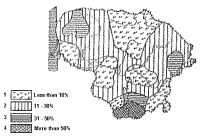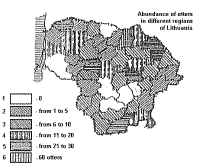 |
Last Update:
Friday November 23, 2018
|
| [Home] |
|
Volume 8 Pages 1 - 47 (February 1993) Citation: Mickevičlus, E. (1993) The Otter in Lithuania. IUCN Otter Spec. Group Bull. 8: 29 - 31 Eduardas Mickevičlus Institute of Ecology, Theriological Laboratory, Akademijos 2, Vilnius 2600, Lithuania
It is necessary to present some facts about Lithuanian rivers and lakes before problems of otters will be discussed. RIVERS AND LAKES The territory of Lithuania is 65 200 km2. There are only two big rivers - Nemunas and Neris (their length is more than 500 km), 17 medium-length rivers (their length is 100 to 500 km) and more than 29 000 small rivers (their length is less than 100 km). The total length of Lithuanian rivers is 63 700 km. Small rivers make 94 % of the total length of the Lithuanian rivers. The total length of unregulated rivers of Lithuania Is only about 17 000 km. The average density of the rivers net is 1,2 km/km2. The naturality of Lithuanian rivers (according to parts of unregulated river-beds) is shown in Fig.1.
There are about 6000 lakes In Lithuania. 2850 of them are bigger than 0,5 ha, but only 17 are bigger than 10 km2. The majority of lakes are concentrated in 5 regions of Lithuania (there are 44 regions). These regions are: Ignalina, Lazdijai, Molêtai, Trakai and Zarasai. The biggest number of lakes in these regions are connected with each other. Some conclusions can be drawn from statements which are mentioned above:
OTTER STATUS IN LITHUANIA It must be stated that the true status of the European otter is still unknown in Lithuania. It Is because of the small number of scientific investigations on otters done in Lithuania and the lack of reliable data. The estimate of Lithuanian game fauna (it includes otters) is done in Lithuania yearly but the data of otter numbers are very unreliable and fully incorrect sometimes. The map of otter distribution and density in Lithuania (Fig. 2.) is based on these questionable otter data, but when there are no other more reliable data it must be published.
According to the official otter data there were 420 otters in 1990 and only 340 in 1991 in Lithuania. Otter presence is proved only in 35 regions of 44 in Lithuania in 1991. It must be asserted that these data are considerably diminished. Investigations were done in 1991 and their results allow us to maintain that otters live in all 44 regions of Lithuania. This fact means that the data from at least 9 regions where the presence of otter was not proved are incorrect. There are two reasons why otter estimate data are very unreliable:
Such a vague situation with otter status forced the Lithuanian Environmental Protection Department to assign means to create survey methods and to include the otter into Lithuanian Red Data Book as an insufficiently investigated species. OTTER CONSERVATION Otter conservation measures may be divided into two groups: direct
conservation measures and indirect conservation measures. Indirect conservation is conservation of habitats suitable for otters. It is well known that otters prefer to dwell in unregulated rivers with dense riparian vegetation, i.e. in habitats where the natural environment is still intact. Such habitats are of high value not only in case of otter presence there but for many other reasons, too. Realising the value of such habitats the group of geographers lead by Dr Povilas Kavaliauskas created a plan to conserve small rivers in Lithuania. The first 12 small rivers reserves were set up in 1974. Now there are 33 such reserves in different parts of Lithuania. The work to set up the net of hydrological and hydrographical reserves is going on in Lithuania and another 36 reserves would be set up in the near future. When this work is finished it will be possible to state that almost every valuable small river is under protection in Lithuania. REFERENCES Kavoliauskas, P. & Vaitkevičius,
E. (1990). Mazųjų upelių likimas. (The state of small
rivers) Vilnius, Mokslas. 94 pp. |
| [Copyright © 2006 - 2050 IUCN/SSC OSG] | [Home] | [Contact Us] |

